Site Search
- resource provided by the Forum Network Knowledgebase.
Search Tip: Search with " " to find exact matches.
BD contacted the Corporate listserve to ask questions to benchmark Community Service/Volunteer Paid Time Off Policy & Internal Company Guidelines for Volunteer Councils. They are formalizing some of their programs and wanted to see what other companies are doing.
Community Service/Volunteer Paid Time Off Program – BD allows US employees 2 days off for personal volunteer time with several restrictions on organization types. We have guidelines but no formal policy. Currently we don’t track participation or hours. To help us, please answer the following questions:
Do you have a Community Service/Volunteer Paid Time Off Policy/Program? If so:
- How many paid days off per year are given to employees?
- Is your program limited to just US employees or are International employees included?
- Are there any limitations to the types of volunteer projects/organizations that are acceptable?
- Is the time off limited to company-sponsored projects or is it open to individual employee volunteer experiences?
- Is manager approval required and if so, how is this tracked?
- How do you track the volunteer hours?
- Does the policy fall under the responsibility to Human Resources or Corporate Social Responsibility?
- Would you be willing to share your policy please?
Company Employee Volunteer Councils – BD has groups of employees at most of our sites who organize volunteer projects for local employees to participate in. We call these groups Volunteer Councils. We do not have any written guidelines for the Volunteer Councils but feel this would be helpful especially in reporting outcomes to our Corporate Social Impact Team. To help us, please answer the following questions:
Do you have Volunteer Councils who coordinate and manage volunteer activities for your site locations? If so:
- Do you have guidelines on how these Volunteer Councils should operate?
- Are there any restrictions on the type of volunteer projects that associates can manage on behalf of the company?
- Do you provide any Corporate grant dollars for the Volunteer Councils to use to support their nonprofit partners?
- Would you be willing to share your guidelines please?
Responses came from 17 corporations from the CNJG community and other corporate giving programs from different areas of the country.
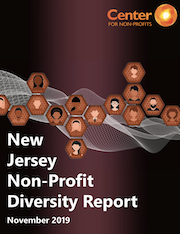
The Center for Non-Profits sought to explore the state of New Jersey non-profit staff and boards in terms of racial and ethnic diversity along with gender and other indicators. In late 2018, they conducted the New Jersey Non-Profit Compensation and Diversity Survey, a comprehensive examination of staff compensation, and of diversity in leadership and staff diversity in the state’s non-profits.
Their survey showed that the same diversity and equity problems documented elsewhere in the country are all too apparent in New Jersey also. The study underscores the enormous challenges facing the non-profit community to overcome deep- seated inequities in leadership, recruitment and retention.
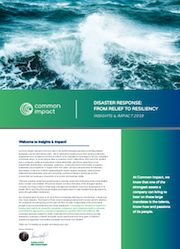
There is a stronger, more strategic role that companies can play by leveraging skills-based volunteering to invest in a community’s resilience.
This report shares the findings, an approach and practical tools to enable companies to tap into the skills and know-how of their employees and equip our communities to anticipate, survive and bounce back from disaster.
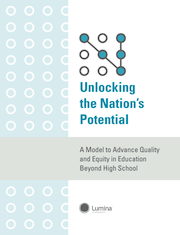
A report from Lumina Foundation and its Quality Credentials Task Force calls for a coordinated national effort to ensure equitable access to quality postsecondary education in the United States.
The report, Unlocking the Nation's Potential: A Model to Advance Quality and Equity in Education Beyond High School (32 pages, PDF), found that the current U.S. system of degrees, certificates, industry certifications, and other credentials lacks a comprehensive definition of quality as well as the kind of up-to-date indicators needed to drive improvements in policies and practices. To help guide efforts that ensure access to high-quality educational opportunities for students of color and advance racially and economically just outcomes, the task force — which includes nearly two dozen education, policy, and workforce development leaders — proposes a model based on a shared understanding of what a quality credential is, as well as institution-based curricular changes and systemic reforms at the federal and state levels.

For decades, aging and HIV/AIDS and their medical, governmental, community, and philanthropic structures and services were worlds apart. This made sense at first, when the majority of the first generation of people affected by HIV were young gay men, many of whom got their care in HIV-specific or infectious disease settings. The odds of living a long life with HIV/AIDS were small, and even survivors did not seek traditional aging services.
Those circumstances have now changed. Thanks to advances in treatment, the ability to live for decades with HIV has become a remarkable success story. Add to this the reality of older people who are acquiring the infection in their 50s or 60s, and HIV/AIDS must now be included as an aging issue. Of the 1.1 million people in the United States who are living with HIV/AIDS, half are 50 or older (50+). By 2030, it is anticipated that three out of four people who are living with HIV will be 50+.
The whole-person outlook and community-based approach of aging services has the potential to bring comfort to this resilient but overlooked group of people. This report will raise the voices and examine the needs of older people living with HIV, while exploring opportunities for philanthropies to create meaningful impact in public and personal health and wellbeing.
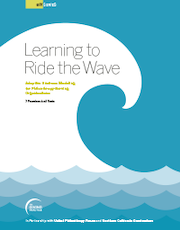
Developed in partnership with United Philanthropy Forum and Northern California Grantmakers, this guide shares seven practices and 12 tools for Philanthropy-Serving Organizations who seek effective ways to mobilize resources to sustain their organization’s work. The guide features perspectives from dozens of leaders of national and regional PSOs and examples from our work with these organizations. Much of the content is based on conversations and strategy work with PSO leaders, staff and board members.
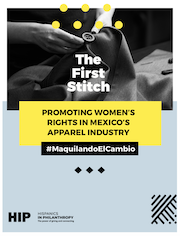
This report from Hispanics in Philanthropy, highlights both the circumstances that women face in the apparel industry and the broader economic environment in which apparel companies operate, which significantly affects how these companies treat their employees. It aims to provide philanthropies that focus on women’s well-being – especially those interested in guaranteeing equitable access to safe and fair work for women – with an innovative example of how they can direct their efforts: supporting projects that directly engage the private sector in examining the causes of injustice and human rights abuses and ultimately ameliorating them.
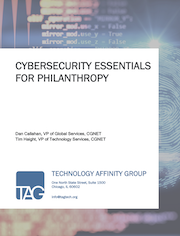
Technology Affinity Group (TAG), a non-profit membership organization that promotes the power of technology to advance the goals of the philanthropic sector, has released two new resources as a part of its Cybersecurity Essentials for Philanthropy series - How to Conduct a Risk Assessment and A 360 ̊ View of Security. These publications offer best practices and suggestions based on the collective on-the-ground knowledge and experience of philanthropic organizations across North America.

Racial Equity Tools is designed to support individuals and groups working to achieve racial equity. This site offers tools, research, tips, curricula and ideas for people who want to increase their own understanding and to help those working toward justice at every level – in systems, organizations, communities and the culture at large.
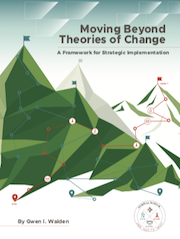
Effecting systemic change through philanthropic initiatives requires not only a strategy but a well-constructed implementation plan focused on "people, partners, and platforms.” According to a new report, Moving Beyond Theories of Change: A Framework for Strategic Implementation, philanthropic organizations hoping to achieve impact must align the partners, approaches, and organizational commitments before they begin to design programs, issue Requests for Proposals, or even hire staff. The report further suggests frameworks should include diversity, equity, and inclusion (DEI) efforts and partnerships with intermediaries and donor collaboratives.
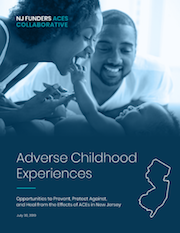
The Burke Foundation, The Nicholson Foundation and Turrell Fund, in collaboration with FSG, has released the new July 2019 report, Adverse Childhood Experiences: Opportunities to Prevent, Protect Against, and Heal from the Effects of ACEs in New Jersey. The report details the challenges New Jersey faces in addressing Adverse Childhood Experiences (ACEs) and calls for a coordinated statewide response to mitigate their lasting effects on children’s health and well-being.
How has place-based family philanthropy evolved over time? Rather than look first to comparing the contrasting decisions—why a place or issue basis for giving—this study is designed to examine how family foundations and funds committed to place are sustaining (or not sustaining) that commitment over generations.
Foundation funding in support of global human rights initiatives totaled $2.8 billion in 2016, up from $2.4 billion in 2015, according to the report from Candid and the Human Rights Funders Network. The report from the Advancing Human Rights research hub found that 785 funders in 43 countries awarded 23,016 grants to 13,242 organizations working to address the root causes of injustice and inequality and ensure the protection and enjoyment of internationally recognized human rights. Twenty-one percent of those grant dollars were awarded in the form of general support grants.
This toolkit is for seasoned donors, donor advised fund holders, foundation trustees, and staff who are taking steps to significantly ramp up the impact of their giving. No longer content with just “making good grants” or “doing good things for the community,” you have taken a fresh look at your goals, strategies, and outcomes and decided that you could do things differently to achieve even more.
We all know that setting bolder, bigger goals for impact is only step one. Implementing strategies and achieving these goals typically involves a winding path full of experiments, iterations, and obstacles. This toolkit is crafted to help seasoned funders anticipate common obstacles to high-impact philanthropy and learn about effective strategies to overcome them.
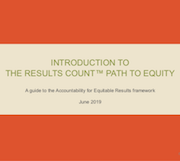
This introduction describes four skills that help leaders to achieve better and more equitable results. The skills are part of Results Count™, the Annie E. Casey Foundation’s competency-based approach to leadership development. Through Results Count, leaders can develop and practice these skills over time to become more powerful and effective in their work. The skills touch on maximizing one’s contribution through data-driven and equity-informed analyses and performance measures.
Through the Kids Count Data Center you can access hundreds of measures of child well-being, incluing all those regularly used in the Annie E. Casey Foundation's Data Book. Information can be examined at the state, regional, and national levels.
Guide your philanthropy clients through the complexities of their work in diversity, equity and inclusion (DEI) with our DEI Toolkit for Consultants to Grantmakers. Help consultants and grantmakers alike look through issues with a DEI lens. The toolkit consists of key resources recommended by leading experts whose work focuses on DEI and its significant impact in the philanthropic sector.
This toolkit defines the professional knowledge, skills, and abilities expected of grants management professionals regardless of area of specialization, the size of your organization or role within the field. By identifying both the functional responsibilities and the knowledge needed for success in every area of grants management, the competencies provide a comprehensive look at the profession. This model offers everyone working in grants management a pathway to professional success.
Seeking ways to maximize the social and economic returns of their place-based impact investments, foundations, CDFIs, private investors, and others are turning to collaboration. To support these efforts and facilitate lesson sharing, the Urban Institute and Mission Investors Exchange have produced a set of three practitioner briefs designed to focus on elements of place-based impact investing that have surfaced in research and conversations with practitioners as opportunities for knowledge exchange: building strong ecosystems, mapping opportunities and capacities, and deploying capital on the ground together through impact investing collaborations. Each brief presents the concept, highlights practitioner examples, and elevates lessons from the field.
Frontline Solutions released the Equity Footprint, a toolkit to help philanthropy assess the impact of a philanthropic organization on communities. The Equity Footprint framework report includes guiding questions in seven different domains to help leaders begin to assess their foundation’s footprint.
